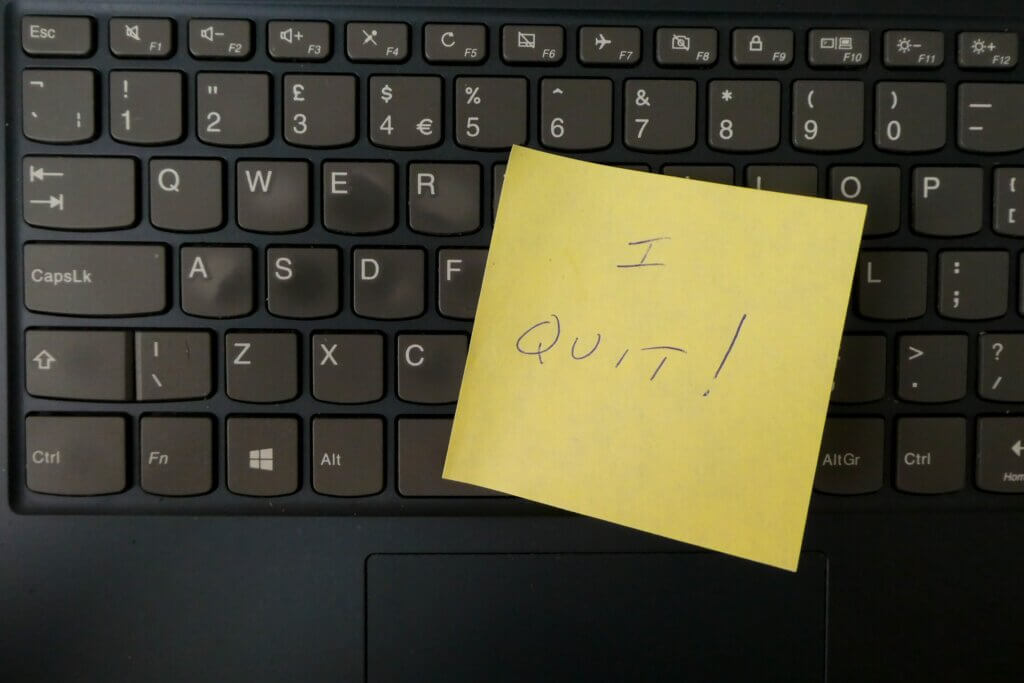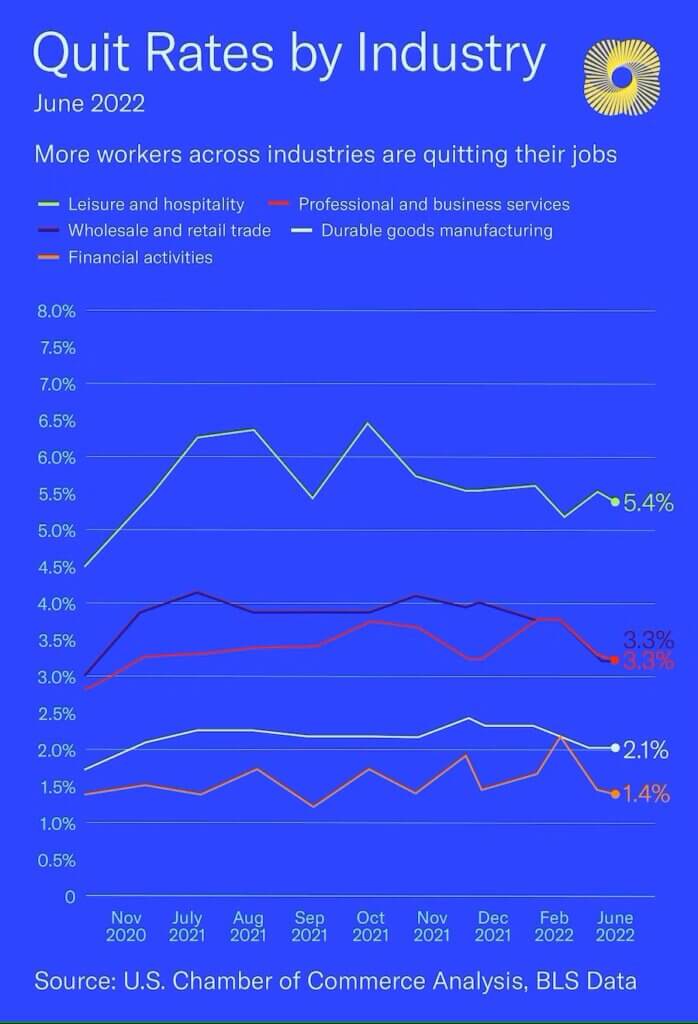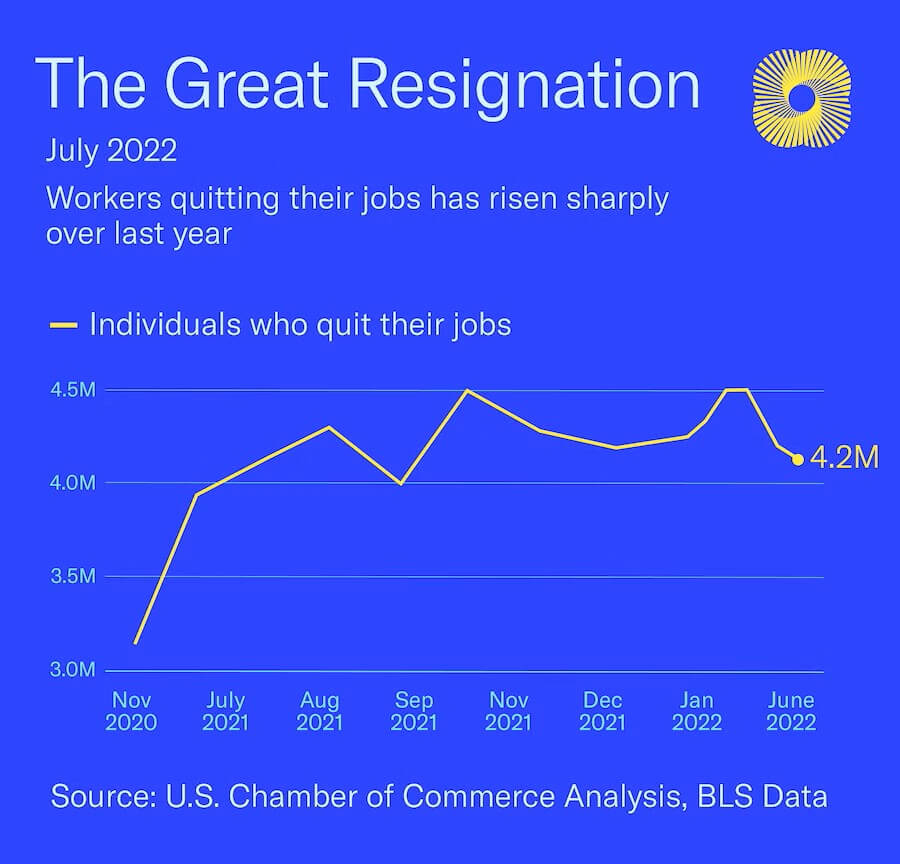
The Big Quit, the Big Reshuffle, or the Great Attrition. Whatever you want to call it, you probably have heard the stories of employees leaving their jobs en masse for better opportunities during the COVID-19 pandemic. This mass exodus of talent led up to 4.5 million American employees to leave their jobs for greener pastures in 2021. It’s what was called by many economists: The Great Resignation of the COVID-19 Pandemic.
This movement was thought to have mainly been caused by remote workers having too much time on their hands and questioning their career paths. As COVID-19 and work-from-home orders ended, some employers were thrilled with the prospect of their employees refocusing their energies back on their current jobs. However, a big surprise came in 2022 when resignation letters continued to pile up even with the world phasing out of the pandemic.
The Great Resignation is still ongoing in North America. This movement is especially hitting industries such as Leisure and Hospitality, Food, Tech, and Health Care companies, but its impact has absolutely also been felt in the Engineering industry. Matchfield has explored what is still causing the Great Resignation in 2022, how it’s currently affecting the labor market, and what companies can do to curb its effects.
The Great Resignation is Not Over
As the COVID-19 pandemic progressed in 2020, The Great Resignation was primarily seen as a fluke. Many theorized it would soon wane out as the world returned to normal. Some even claimed employees would regret leaving their jobs and would warn against others engaging in this culture of resignation.
Nevertheless, the pandemic shifted the importance of work-life balance to employees. Long commutes and working 5-days a week in an office, with 8+ hour days, have become almost antiquated practices among many modern-day companies. Indeed, a rigid work structure is what’s causing a staggering 20% of employees planning to quit their current jobs in 2022.
On the other hand, there’s a concern amongst employees regarding high inflation and housing costs in the current economy. These economic fears have indeed led to slower resignation rates in 2022 compared to 2021. Yet, perhaps because of these concerns coupled with a desire for a better work alternative, there is another ripple effect from the Great Resignation.
Quiet Quitting is a term used to describe the culture of not going above and beyond a worker’s job description. Quiet Quitting has become a widespread discussion in the workplace today. This trend is mainly seen among Gen Z employees entering the workforce. However, that shouldn’t deter you from hiring them.
How The Great Resignation will Influence the Job Market
The Great Resignation and its offspring, Quiet Quitting, are not going away soon. High attrition rates that companies are seeing have led to a candidate market where demand for talent is high, but supply is low. Moreover, as inflation and interest rates continue to climb, many employers theorize this will lead to a larger pool of talent as people need work to afford an ever-growing cost of living. There’s a big snag in this plan, though.
The Great Resignation has led to even greater innovation and entrepreneurship in laborers. Workers who once felt tethered to one company are now seeking multiple contract work or are even starting their own businesses. As a result, new business applications continue to rise as employees want more autonomy in their careers. Workers are seeing rising inflation against capped wages at their current jobs and are considering alternative routes such as multiple contract work or self-employment.
This game of tug-a-war between talent and employer can only end if both sides drop the rope and learn to further compromise on working conditions, pay, and accountability.
What Can You Do to Avoid The Great Resignation?
Companies struggle to retain and attract talent simply because they’re still inundated with more old-fashioned work culture, wages, and practices. Yes, many people are currently looking for jobs right now. There are always going to be people who apply to any job that accepts resumes. But if you want to attract the best and brightest amongst the masses, i.e. the candidates who bring in revenue, it would be best to show your company as forward-thinking and contemporary as possible.
Why is this important? To simply put it: the game has tipped in favor of the employee. Poor management styles are no longer tolerated as much as before. Highly qualified candidates are looking for three main criteria when sourcing a new job:
- Competitive and transparent compensation
- Room for growth within the company
- More flexibility and work-life balance
More companies are beginning to see the value in offering these to candidates. If you don’t want your competitors to snag your employees, it would be beneficial to implement these strategies.
A good place to start is to speak with your existing employees and ask for feedback on what they want. Showing a genuine interest in work culture can significantly decrease attrition rates in a company. In addition, highlighting what makes your company forward-thinking and flexible is a cost-effective way to attract new candidates to your company.
Think back to what you wanted as an employee. You probably wanted fair compensation, flexibility, and growth opportunities in your job path. The same applies to your current and future employees.
Now is the Time for the Great Reshuffle
Although change can be complex, and the Great Resignation and Quiet Quitting may seem like a risk to productivity, the numbers show there’s no need to fear. A flexible and open work culture often leads to even more productivity, company loyalty, and a better overall company reputation.
The Great Resignation has also allowed companies to reshuffle their work cultures. If there’s ever a time to hand in the resignation letters of outdated work practices, now is the time.
Follow Matchfield on LinkedIn and Twitter to stay-up-date on effective hiring practices during 2022.


